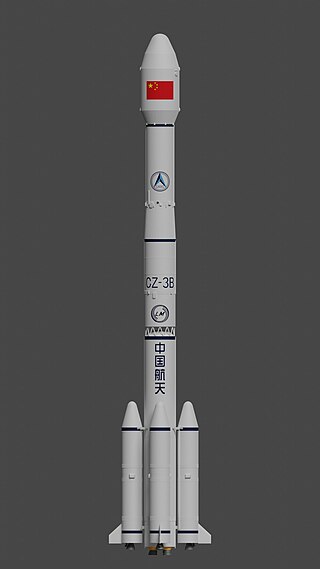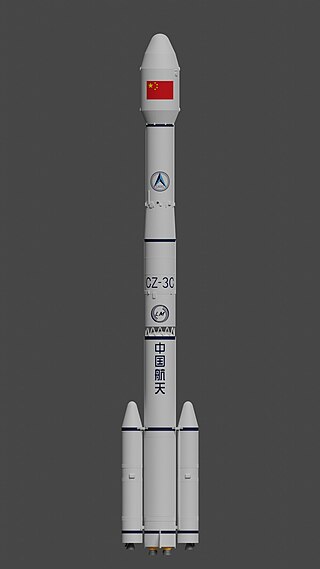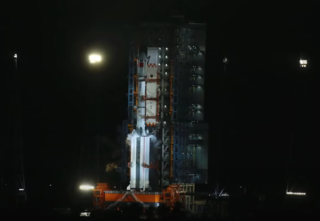
The Long March 3, also known as the Changzheng 3, CZ-3 and LM-3, was a Chinese orbital carrier rocket design. They were all launched from Launch Area 3 at the Xichang Satellite Launch Center. It was a three-stage rocket, and was mostly used to place DFH-2-class communications satellites into geosynchronous transfer orbits. It was complemented and later replaced by the more powerful Long March 3A, which has an improved third stage.

The Long March 3A, also known as the Chang Zheng 3A, CZ-3A and LM-3A, is a Chinese orbital carrier rocket design. It is a 3-stage rocket, and is usually used to place communications satellites and Beidou navigation satellites into geosynchronous transfer orbits.

The Taiyuan Satellite Launch Center (TSLC) also known as Base 25 (Chinese: 二十五基地), is a People's Republic of China space and defense launch facility (spaceport). It is situated in Kelan County, Xinzhou, Shanxi Province and is the second of four launch sites having been founded in March 1966 and coming into full operation in 1968.
NigComSat-1 was a Nigerian communication satellite. The initial contract to build the satellite was signed in 2004. It was launched in China by Nasrda and became the third African geosynchronous communication satellite, when it was launched at 16:01 UTC on 13 May 2007, aboard a Chinese Long March 3B carrier rocket, from the Xichang Satellite Launch Centre in China. The spacecraft was operated by Nigerian Communications Satellite Ltd (NIGCOMSAT). On November 11, 2008, NigComSat-1 failed in orbit after running out of power due to an anomaly in its solar array.
ChinaSat is the brand name of communications satellites operated by China Satellite Communications.

The Long March 3B, also known as the CZ-3B and LM-3B, is a Chinese orbital launch vehicle. Introduced in 1996, it is launched from Launch Area 2 and 3 at the Xichang Satellite Launch Center in Sichuan. A three-stage rocket with four strap-on liquid rocket boosters, it is the heaviest variant of the Long March 3 rocket family, and is mainly used to place communications satellites and navigation satellites into geosynchronous orbits.

The Long March 3C, also known as the Changzheng 3C, CZ-3C and LM-3C, is a Chinese orbital launch vehicle. It is launched from Launch Complex 2 and 3 at the Xichang Satellite Launch Center (XSLC). A three-stage rocket with two strapon liquid rocket boosters, it is a member of the Long March 3 rocket family, and was derived from the Long March 3B. It was designed to fill a gap in payload capacities between the Long March 3A and 3B.
ChinaSat 9, also known as ZX-9, is a Chinese communications satellite.
Paksat-1R is a geosynchronous, communications satellite that was manufactured by China Great Wall Industry Corporation (CGWIC) and operated by the Space and Upper Atmosphere Research Commission (SUPARCO), an executive space authority of the Government of Pakistan.
Sino Satellite Communications Co., Ltd. known also as SinoSat is a Chinese company.
Saorsat is a free-to-air satellite service in Ireland. The service launched on 3 May 2012.
ChinaSat 10 previously known as SinoSat 5 is a Chinese communications satellite. It was launched at 16:13 UTC on 20 June 2011 on a Long March 3B rocket.
Apstar-7 is a Chinese communications satellite which is operated by APT Satellite as part of the Apstar system. It was launched in 2012 as a replacement for the Apstar 2R satellite launched in 1997.

The ChinaSat 12 communications satellite is wholly owned by China Satellite Communications, with part of its communications payload leased or rented by SupremeSAT, a Sri Lankan company, to be marketed to potential users as SupremeSAT-I. Once operational, it will provide communications services for the China, Sri Lanka, East Asia, South Asia, Middle East, Africa, Australia, and China sea area, the Indian Ocean region.

APT Satellite Holdings Limited is a Bermuda-incorporated holding company. Its Hong Kong-incorporated subsidiary APT Satellite Co., Ltd. is the operator of the Apstar satellite constellation. APT Satellite Holdings and APT Satellite are headquartered in Hong Kong.

Shijian is a series of satellites built and operated by the People's Republic of China. Some Shijian-series satellites have drawn significant concerns from the United States government and space observers who cite unannounced launches, undisclosed sub-satellites deployed in orbit, unusual orbital maneuvers, and demonstrated rendezvous proximity operations (RPO) including the close inspection and towing of other satellites.
ArmCosmos, commonly known as the Armenian Space Agency, is an Armenian private agency responsible for the development of Armenia's commercial space industry, coordinating domestic activities, identifying opportunities and facilitating international space engagement, on behalf of the Government of Armenia. Its headquarters are located in Yerevan, Armenia.
Tianlian also known as CTDRS, is a Chinese data relay communication satellite constellation. The constellation serves to relay data from ground stations to spacecraft and rockets, most significantly China's crewed spaceflight program. The system currently consists of seven satellites in two generations, with the first satellite being launched in 2008.

The Long March 6A or Chang Zheng 6A as in pinyin, abbreviated LM 6A for export or CZ 6A within China, is a Chinese launch vehicle of the Long March family, which was developed by the China Aerospace Science and Technology Corporation (CASC) and the Shanghai Academy of Spaceflight Technology (SAST).








